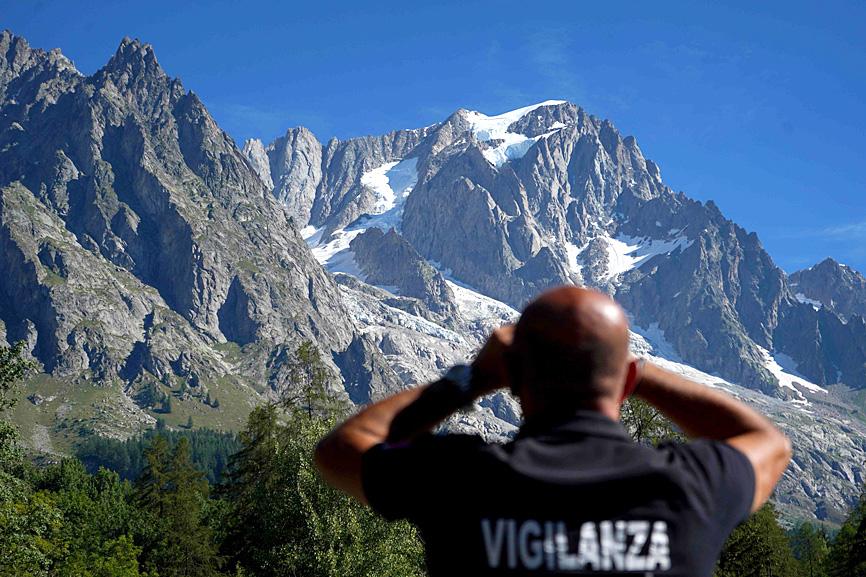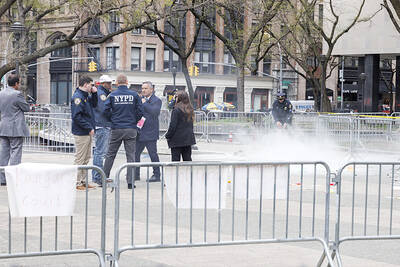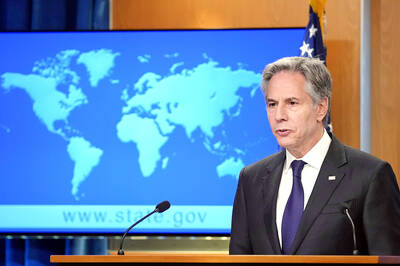An Italian alpine resort on Friday remained on high alert over fears that a vast chunk of a glacier on the slopes of the Mont Blanc massif could plummet in high temperatures.
“No one gets through! No cars, bikes or pedestrians,” was the message at a checkpoint where an automatic barrier and two guards blocked the small road snaking up into a lush valley below the Planpincieux glacier, near the town of Courmayeur and the Italian-French border.
The blockade has largely been greeted with contempt by the locals, one of whom said: “It’s a joke.”

Photo: AFP
The huge ice block measuring around 500,000 cubic meters — “the size of Milan cathedral or a football pitch covered in ice 80m thick,” an official said — could yet break free of its perch about 2,600m to 2,800m above sea level.
Late on Wednesday, authorities ordered the evacuation of a “red zone” at the base of the slope for at least 72 hours, so far moving just 75 people — about 20 locals and the remainder holidaymakers.
At this time of year, the small Val Ferret valley, now blocked off, is usually busy with tourists heeding the call of the mountains.
Located in the Aosta Valley region, the spot is not far from where a vital road tunnel pierces the Alps between France and Italy.
The “red zone” is at least 4km from the tunnel entrance, while tourists could still be seen strolling through the streets of Courmayeur.
It was “urgent and vital” to move people directly out of the path of a potential ice fall, Courmayeur mayor Stefano Miserocchi said, highlighting an “elevated state of alert” during the 72-hour evacuation.
The coming three days are expected to bring especially high temperatures as much of Europe sizzles under a heatwave.
There are more than 4,000 glaciers — vast, ancient reserves of ice — dotted throughout the Alps, providing seasonal water to millions and forming some of Europe’s most stunning landscapes. They are under severe threat from climate change.
A study last year by Swiss scientists found that Alpine glaciers could shrink between 65 and 90 percent this century, depending on how effectively the world can curb greenhouse gas emissions.
At Planpincieux this week, “it’s an especially delicate situation because [the temperature] upsets the water level between the ice and the rock, and in turn the stability of the glacier,” Aosta Valley natural risk management director Valerio Segor said.
“Our problem now is that not enough water can escape; it stays under the glacier like a bubble and risks lifting it up” — which could prompt its most fragile section to tumble into the valley, Segor added.
During a helicopter flyover, a reporter saw a gaping chasm on the lower part of the Planpincieux, from which two cascades of water flowed toward the valley, as it hung from the mountainside like a gigantic block of grey polystyrene.
Last autumn, another section of ice from the Planpincieux glacier threatened to collapse, prompting road closures in the area, and officials have introduced heightened surveillance.
In Courmayeur, as in the small neighboring commune of La Palud, leading to Val Ferret, the evacuation came as an unwelcome surprise, arousing criticism from residents and tourism professionals, worried about the impact on their activity.
In this typically Alpine hamlet, wooden chalets with slate roofs and balconies festooned with pink geraniums and greenery nudge up against hotels and restaurants which advertise their inviting “mountain menu.”
“I looked at where the glacier was, where the danger was. It doesn’t affect the center of Courmayeur at all, so we continued the visit,” said Loic Hamelin, a Parisian tourist who came for the day with his family.
The threat does not appear to have put off the walkers for an instant, as they bustle through the streets with backpacks and boots to start a trail.
“It’s a joke,” said Rocco, who owns a hotel in La Palud. “Every year, they [the local authorities] do the same thing to us. After the COVID-19 epidemic, it’s a new disaster for tourism.”
“We have been receiving calls from worried customers asking if they should cancel their reservation, but there is absolutely no problem,” Rocco said.
Another hotelier in the area, Ludovico Colombati, was equally dismissive after having to evacuate his home, which is “the closest to the glacier,” just under 2km away.
“We live in the mountains, so there is always a risk. But in this case, it is very, very, very low,” said Colombati, whose family has lived in the valley for four generations.
“With climate change, the hot summer, the glacier moves, blocks are detached, it’s normal,” he said, criticizing the “psychosis” of administrators “who cover themselves for fear of having to assume the slightest responsibility.”
“Several times a day, my ears hear the glacier being triggered... That’s life in the mountains, especially when you live at the foot of a wall,” he said.
“The day after tomorrow, it will be all open,” he added.
Nearly half of China’s major cities are suffering “moderate to severe” levels of subsidence, putting millions of people at risk of flooding, especially as sea levels rise, according to a study of nationwide satellite data released yesterday. The authors of the paper, published by the journal Science, found that 45 percent of China’s urban land was sinking faster than 3mm per year, with 16 percent at more than 10mm per year, driven not only by declining water tables, but also the sheer weight of the built environment. With China’s urban population already in excess of 900 million people, “even a small portion

UNSETTLING IMAGES: The scene took place in front of TV crews covering the Trump trial, with a CNN anchor calling it an ‘emotional and unbelievably disturbing moment’ A man who doused himself in an accelerant and set himself on fire outside the courthouse where former US president Donald Trump is on trial has died, police said yesterday. The New York City Police Department (NYPD) said the man was declared dead by staff at an area hospital. The man was in Collect Pond Park at about 1:30pm on Friday when he took out pamphlets espousing conspiracy theories, tossed them around, then doused himself in an accelerant and set himself on fire, officials and witnesses said. A large number of police officers were nearby when it happened. Some officers and bystanders rushed

‘IN A DIFFERENT PLACE’: The envoy first visited Shanghai, where he attended a Chinese basketball playoff match, and is to meet top officials in Beijing tomorrow US Secretary of State Antony Blinken yesterday arrived in China on his second visit in a year as the US ramps up pressure on its rival over its support for Russia while also seeking to manage tensions with Beijing. The US diplomat tomorrow is to meet China’s top brass in Beijing, where he is also expected to plead for restraint as Taiwan inaugurates president-elect William Lai (賴清德), and to raise US concerns on Chinese trade practices. However, Blinken is also seeking to stabilize ties, with tensions between the world’s two largest economies easing since his previous visit in June last year. At the

Beijing is continuing to commit genocide and crimes against humanity against Uyghurs and other Muslim minorities in its western Xinjiang province, U.S. Secretary of State Antony Blinken said in a report published on Monday, ahead of his planned visit to China this week. The State Department’s annual human rights report, which documents abuses recorded all over the world during the previous calendar year, repeated language from previous years on the treatment of Muslims in Xinjiang, but the publication raises the issue ahead of delicate talks, including on the war in Ukraine and global trade, between the top U.S. diplomat and Chinese